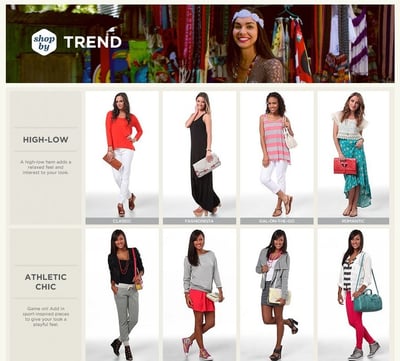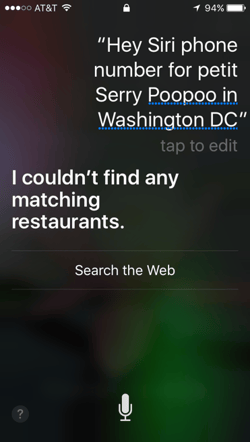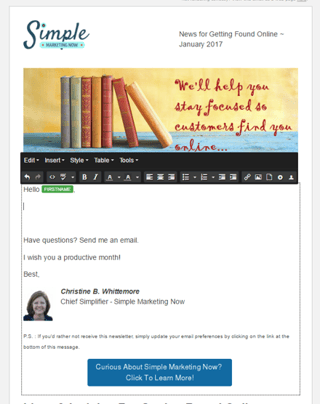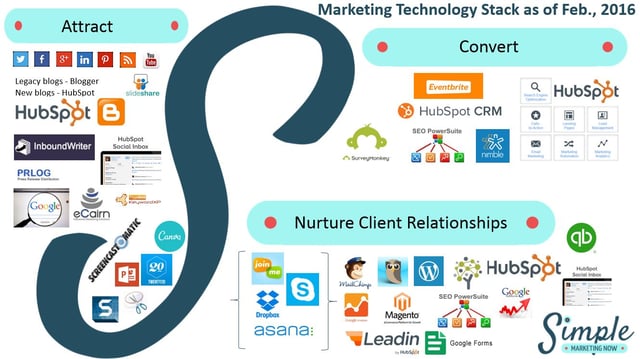
Are you wondering how you might apply the latest social media trends to your business?
I've assembled what I consider to be the top ten to pay attention to. For each one, I offer suggestions on how to make sense of them for business.
As with clothing trends, you may decide the look isn't right or you can simply create a similar look with something you already have.
Regardless, by exploring these 10 social media trends, I hope you gain perspective and possibly uncover ideas you hadn't thought to apply to your company.
Ten Social Media Business Trends for You
To put these trends into perspective, I recommend that you read What’s Behind the Top 10 Social Media Trends of 2017? Digital Change.
That's where I detailed the backdrop against which these trends exist, including the rapidly increasing rate of change in technology. An excellent albeit humbling read on that is Tim Urban's The AI Revolution: The Road to Superintelligence.

Top Social Media Trend #1: Mobile First
When you think how ubiquitous and endlessly useful your mobile device is for staying connected to your business, you may forget how life used to be before mobile, when you depended on pay phones!
Yes, it's a phone and so much more thanks to powerful apps. For perspective, realize that your smartphone is millions of times more powerful than all of NASA’s combined computing in 1969 and you can easily carry it around in your hand.
As the devices evolve, they become better at capturing still and moving images transforming us into storytellers and story consumers.
With our mobile devices we can search. And, as of 2015, more searches take place on mobile devices than on desktop computers! Think of the implications for users and companies.
>> See JUST IN: AdWords Changes Coming May 2015 - EVERYTHING You Need to Know
As a result, Google is Splitting its Search Index, Prioritizing Mobile over Desktop. What that means is,
"Having a separate index for mobile creates an opportunity for Googlebot to strictly crawl the responsive/mobile version of a web page and index it accordingly. This could lead to Google delivering better mobile-optimized content to people searching on smartphones. In addition, with expedited indexing, Google can get breaking news out to users faster than ever before."
Make Sense of 'Mobile First' for Your Business
Action(s): Be Mobile-Friendly in all that you do online. Make sure your website is responsive (i.e., that the site adjusts to the visitor's device) and that your email templates are mobile-friendly. Check that you have the right font sizes and that links aren't too close together.
>> See Is Your Website Mobile Friendly? If Not, Consider Responsive Design.Understand how a web visitor differs from a mobile visitor in intent. If your mobile visitor needs to find details on your business, make sure it's not only easy to find, but also accurate. More specifically, ensure your business NAP (name, address, phone) are consistent throughout your:
- Website
- Directory Listings
- Social Profiles
Add photos to your site and platforms; try a video, too, including Facebook Live.
Encourage online reviews (Google My Business aka Local/maps, YELP, …) and acknowledge those reviews. Google reviews in particular can compensate for your website offering a lousy mobile experience.

Top Social Media Trend #2: Voice Search
Have you noticed how voice search is improving?
And what used to be a mobile only experience is becoming a desktop one, too, where the voice app (Siri or Cortana, for example) can interact with other apps on your computer not to mention Amazon's Echo or Google Home. In some cases, these devices integrate with appliances in your home or simply exist as standalone smart-speakers.
What's fascinating about voice is that, when it works, it's so much faster and easier than typing. And, you can speak while doing other things.
As Mary Meeker documents in the 2016 Internet Trends Report, voice search is now taking off quickly. Why? Because it's getting so much better, so quickly.
By the way, have you noticed searches prefaced with "hey siri" or "ok google" showing up in Adwords? I have.
Make Sense of Voice Search for Your Business
Action: Experiment with voice search and try it on different devices.
Understand the experience – what works/what doesn’t. Some searches are no-brainers for voice whereas others are problematic.
Monitor results over time - especially since voice is quickly evolving. As you do, be sure to test your business & category (See #1.)

Top Social Media Trend #3: Wearables
Do you have a Fitbit, an Apple watch or some other type of wearable device?
Wearables are interesting because they provide you with immediate feedback on your body or other activities in a pared-down way. They integrate with a mobile device app or desktop to provide better graphics and insights; many include a social element, too.
You've probably seen examples of wearables used in fashion and entertainment - think the Olympic opening ceremonies or Super Bowl half-time shows where lighted clothing changes color.
>> See SXSW Trade Show. When Fashion Meets Technology
Even more interesting is what can happen when technology is fully blended with fashion to provide usefulness (e.g., a location-enabled jacket) or to channel what your favorite player feels during an intense sports event. These are the kinds of wearable experiments that designer Billie Whitehouse develops.
>> See The fashionable future of haptics starts with Wearable Experiments
You can watch and listen to Billie Whitehouse in this 10 minute video from the BRITE'15 Conference as she discusses designing for humans in a digital age and bringing together fashion and technology with a functional aesthetic to connect people in a whole new way.
>> Watch Designing Fashion in a Digital Age
Imagine how wearables might evolve - say for better vision or hearing - as technology evolves. For example, Meet The New Wave Of Wearables: Stretchable Electronics describes electronics as pliable as a temporary tattoo.
Make Sense of Wearables for Your Business
Action: Try Out a Wearable
How does it affect your behavior?
Does it encourage you to connect with others?
What data are you getting?
How does the wearable communicate most effectively with you?
How might it be relevant to your business?
Top Social Media Trend #4: The Sharing Economy
The sharing economy whereby, rather than owning, you share has been building momentum. Bike sharing in cities is commonplace; you no longer think twice about using Uber or Lyft to get from one place to another; AirBnB is a natural hotel alternative with the added bonus of an insider's perspective on a neighborhood. Even office space can be shared.
Mary Meeker's Internet Trends Report lists as the top reasons for riders choosing Uber:
- 93% want to get to a destination quickly
- 87% for safety
- 84% have had too much alcohol to drive
- 83% to save money
- 77% want to avoid dealing with a car
- 65% prefer this option during off public transit hours
What makes these programs different from past sharing is that both parties need a mobile device to participate in them. Not just to communicate but also for reviews and references that stay with you over time.
Make Sense of the Sharing Economy for Your Business
Action: Participate in the Sharing Economy
What do you like/not like?
How does it integrate with mobile/notifications?
How is it social?
Pay attention to the review process.
How might sharing be relevant to your business?

Top Social Media Trend #5: Search is… evolving
Search engine dynamics have morphed considerably, away from simply matching specific search terms to matching intent. Depending on your context (location, mobile vs. desktop, time of day, past searches, etc.), the same search may yield completely different results
>> See How To Get Found On Google
To enable this, search algorithms are becoming increasingly complex and intelligent. For more on that, definitely read How Google uses machine learning in its search algorithms.
Make Sense of the Evolution of Search for Your Business
Action: Regularly Test Search
Mobile vs. desktop
Search different categories as well as yourself/your company
Try voice (see #2)
What changes do you notice? How are results presented?

Top Social Media Trend #6: Personalize It! (Think Customer Experience)
Personalization is powerful and, thanks to digital technology, so much easier to implement at scale. Using a person's name and referring to details relevant only to that person demonstrate that you care about who you're communicating with and that you're listening carefully. Look at how Amazon uses it, and how you respond to emails that include your own name.
So why not make use of personalization and automation tools available in your email software, your content management systems and even in lower tech tools?
Make Sense of Personalization for Your Business
Action: Personalize & Customize Customer Communications & Interactions
Use personalization tokens in email.
Send follow up messages that are relevant to the recipient.
Add your photo in your email signature and your email newsletters.
Experiment with paid search and social search; both offer rich segmentation data that can allow you to customize your ads and be more relevant.
Pay attention to personalization and customization around you; you may get useful ideas you can apply to your own business.
Top Social Media Trend #7: Collaboration Technology
Collaboration technology helps make work much more social. In fact, many of the tools include aspects from social networks such as being able to notify others on your team using @name, tracking comments, attaching images and documents. They operate in the cloud and you can access them via your desktop as well as your mobile device.
Examples include DropBox, Google hangouts, and Smartsheets.
And many of these tools incorporate chatbots to help you. Bots use machine learning to offer simple services and natural language processing, like Siri. For example, upon getting started with Slack, a messaging app for teams, you'll meet Slackbot to help you become familiar.
>> See How messaging bots will change workplace productivity
>> See How Chatbots and Artificial Intelligence Are Evolving the Digital/Social Experience
Make Sense of Collaboration Technology for Your Business
Action: Implement Collaboration Technology
Experience how technology can make collaboration easier within your company.
Think cloud-based vs. IT
Try the mobile component
Try out some bots. Maybe they'll trigger ideas for helping your customers.

Top Social Media Trend #8: What’s Your Marketing Technology Stack?
If you aren't using digital technology in your business, you're operating at a significant disadvantage. At the same time, given how much growth there's been in that category, how are you integrating the various tools you use?
To highlight how much the marketing technology landscape has grown, realize that in 2011 ~150 vendors existed. That number increased to 1,876 vendors represented across 43 categories in 2015. The latest count is 5000 as of 2017.
>> See Marketing Technology Landscape Supergraphic (2017): Martech 5000
Make Sense of Your Business Marketing Technology Stack
Action: Create Your Own Marketing Technology Stack
You see mine above. Since 2016, I've added a few. It's a worthwhile strategic exercise to help make sense of the complexity of running a business.
>> See What's Your Marketing Technology Stack?

Top Social Media Trend #9: Open Social Networks (Especially Facebook)
Open social networks are those where you can lurk, listen to, participate in and share publicly. At the top of the list of networks you find Facebook which remains the most popular social media platform with 79% of online adults, and 76% using it on a daily basis per Pew Research Center 2016. It's hard to ignore. In fact, it's become the new mass medium for reaching online adults.
However, when it comes to shopping, Pinterest is more useful than Facebook according to Mary Meeker's report.
And the best overall use of social media? Customer service, according to Jay Baer in 5 Reasons Social Customer Service is Now a Criticial Social Component.
As popular as Facebook may be, be sure to understand which social networks matter to your customers, and what they do on those networks so you can be prepared in terms of response and also content, images and video. Check your website analytics, too, so you know which sites send traffic to your site.
>> See Social Media Networks Roundup: Which Ones Matter to You?
Keep in mind, too, that to participate in open social networks effectively, you'll need to pay once the network establishes a significant audience. Once that happens, you'll have access to hyper-focused opportunities to target specific audiences, test different approaches and determine what works best for your business.
Make Sense of Open Social Networks for Your Business
Action: Experiment With Open Social Networks
Know your business goals for social networks (i.e., stay focused) and then experiment.
Ask your customers where they hang out/get shopping ideas (may be different).
Experiment and measure regularly Including social ads.
Engage your associates (develop social media guidelines).
Understand personal vs. business differences.
Be ready to respond to customers on social channels.

Top Social Media Trend #10: Dark Social Media
'Dark social media' refers to non-public or private activity online, as in private web browsing (where your search history doesn't follow you), email (yes!), direct messages on Twitter and other networks and also messaging apps.
Messaging apps is where the growth has happened with use now surpassing that of open social networks especially with younger smartphone users.
Some apps like Snapchat represent digital paradigms with disappearing messages (vs. permanent digital trails) and sequential storytelling.
Many of the open networks have purchased or created their own messaging apps (e.g., Facebook Messenger) where you'll discover helpful bots to take your pizza order or help you reserve a hotel room. Eventually, all kinds of functionality will be thoroughly embedded within each app able to offer highly personalized communications and experiences.
>> See How to Find and Use a Facebook Chatbot
Make Sense of Dark Social Media for Your Business
Action: Experiment With Different Types of Dark Social
What’s different?
How is it useful?
Can the ‘disappearing message’ concept inspire something for your business? (In-store events???)
Remember your goals so you stay focused.
Analyze the data
Don’t forget email!
Ten Top Social Media Trends and How to Apply Them to Your Business
Here's the presentation that offers more detail on these trends:








